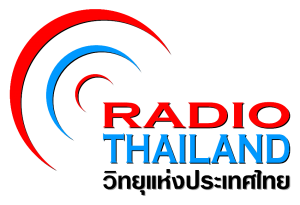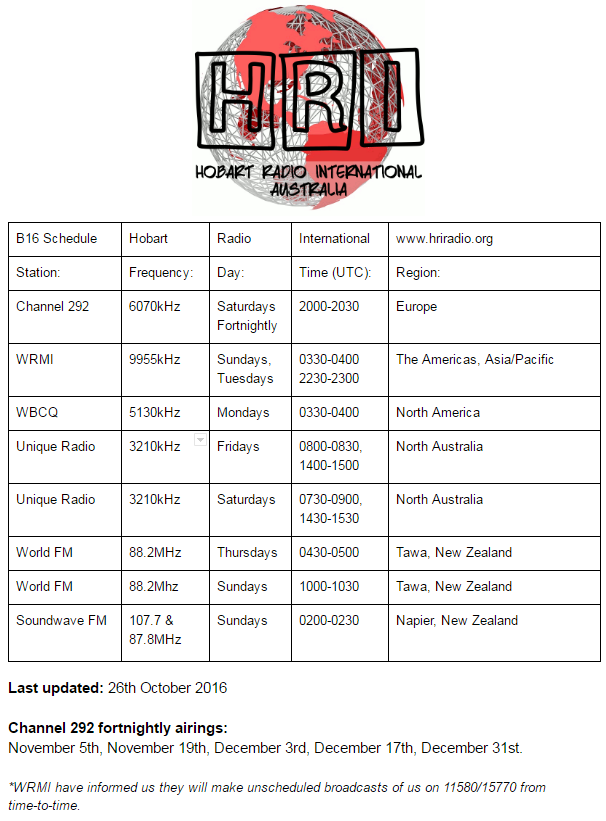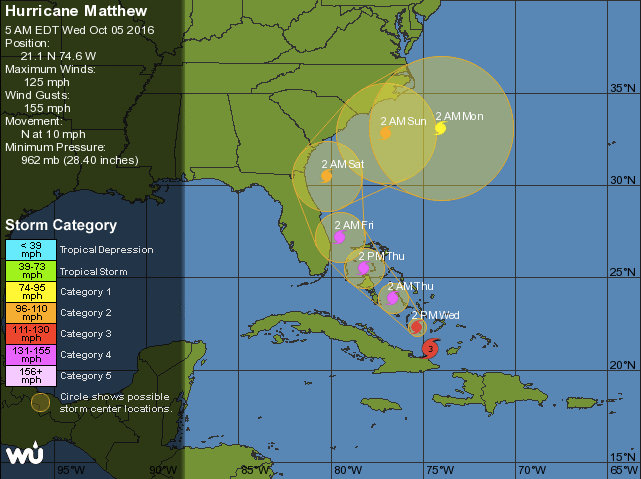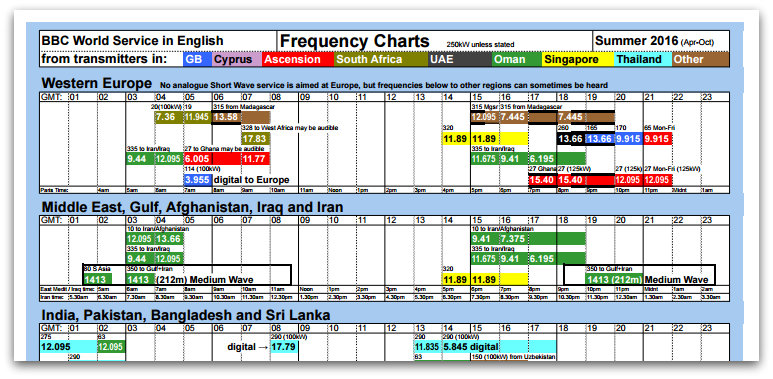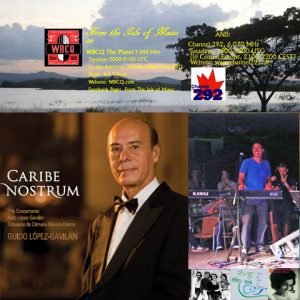Many thanks to SWLing Post contributor, Paul Walker, for sharing the following updated schedule from Radio Thailand World Service: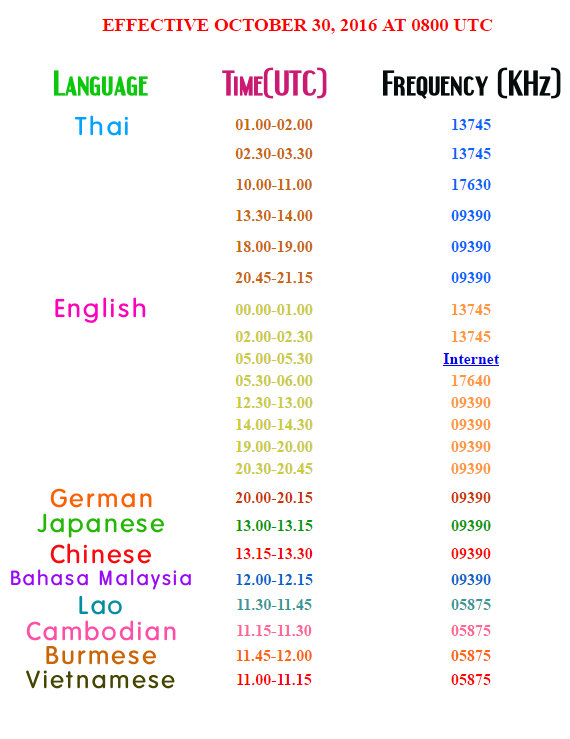
Category Archives: Schedules and Frequencies
Radio New Zealand International B16 schedule
Many thanks to SWLing Post contributor, DanH, for sharing the latest schedule from RNZI:
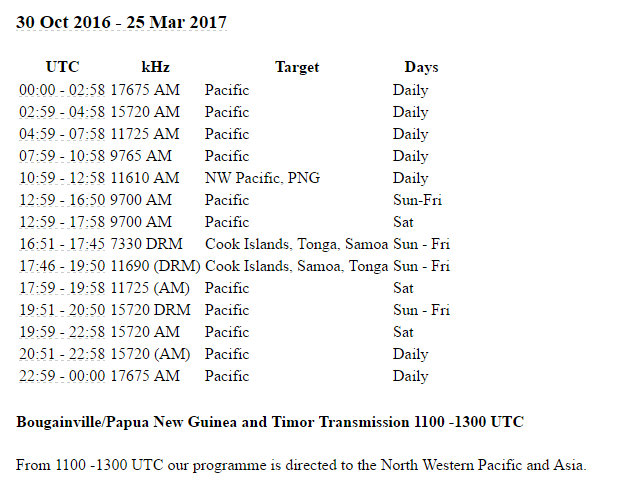
Hobart Radio International B16 schedule
(Source: Hobart Radio International on Facebook)
We’re getting ready for the B16. Here is our new schedule. Changes include WRMI reductions and Ch292 commencement. We air for the first time on Channel 292 6070 Nov 5th.
Hurricane Watch Net frequencies: monitoring “ground truth” observations
As Hurricane Matthew makes its slow trek through the Caribbean, it is expected to have impact on the Bahamas, Florida, South Carolina and North Carolina. It has already battered Haiti and Cuba.
A few readers have asked about frequencies to monitor as the storm approaches.
Hurricane Watch Net (HWN)
 The Hurricane Watch Net is a group of amateur radio operators who are trained and organized “to provide essential communications support to the National Hurricane Center during times of Hurricane emergencies.” The HWN focuses on “ground truth” observations (much like SkyWarn nets).
The Hurricane Watch Net is a group of amateur radio operators who are trained and organized “to provide essential communications support to the National Hurricane Center during times of Hurricane emergencies.” The HWN focuses on “ground truth” observations (much like SkyWarn nets).
The Hurricane Watch Net is activated when a hurricane is within 300 statute miles of expected land-fall. The HWN covers the Caribbean, Central America, Eastern Mexico, Eastern Canada, and all US Coastal States.
The HWN operates in both English and Spanish, and is active on 14.325 MHz (upper sideband) during the day and 7.268 MHz (lower sideband) at night. The HWN is known to operate on both frequencies if propagation allows.
Please keep HWN frequencies clear
If you’re an amateur radio operator, please avoid using 14.325 MHz and 7.268 MHz anytime the HWN has been activated.
Other emergency net frequencies
ARRL Southern New Jersey Section manager, Skip Arey (N2EI), recently noted several other frequencies being used in the Caribbean:
“CO2KK reports the Cuba National Emergency Net is operating on 7110 primary, 7120 secondary in the daytime, with provincial nets on 7045, 7080 and possibly others. At night the primary is 3740 and secondary 3720. The main net control station is CO9DCN, operating from the Cuban National Civil Defense Headquarters, in Havana, with CO2JC in charge. Volunteer hams across the island nation are going portable to check on flooding of rivers and roads and plan to report in.
The Dominican Republic on Cuba’s eastern neighbor, the island of Hispaniola, is using 7065 kHz LSB for emergency communications.”
Please note these frequencies and, again, keep them clear of non-essential communications.
Monitoring hurricane frequencies
If you have a shortwave radio with a BFO/SSB mode–and you live within the propagation footprint–you can monitor the Hurricane Watch Net.
Note that you’ll need to use upper sideband on 14.325 MHz and lower sideband on 7.268 MHz.
You can also monitor the Hurricane Watch Net via the following web stream: http://www.broadcastify.com/listen/feed/20970/web
Alex updates shortwave frequency charts for 2016 summer season
Many thanks to SWLing Post reader, Alex, who has just informed me that he’s updated his printer-friendly shortwave frequency charts for the summer broadcasting season. Alex mentions that he posted English in Europe on one A4 sheet, plus 5 A4 sheets running through the vast majority of stations that can now be heard in Europe.
Note that Alex creates his charts based on listening to broadcasters rather than importing schedules from other sources.
You can download the free charts on his website:
Shortwavetimes.com
Many thanks, Alex!
From the Isle of Music for August 15/16
From The Isle of Music reports:
Our August 16 (August 15 in the Americas on WBCQ) program
marks the beginning of several weeks of Caribe Nostrum, winner of Cubadisco 2016 in the Concert and Chamber Music category and one of the two Gran Premio winners. Guido López Gavilán, the Director, will join us each week to talk about the recording. Our other special guest will be Roberto Carcasses, leader of Interactivo, one of the most exciting modern music ensembles in Cuba today. And, of course, we will have a few other musical surprises.
Two options for listening on shortwave:
WBCQ, 7490 KHz, Tuesdays 0000-0100 UTC
(8pm-9pm EDT Mondays in the Americas)
Channel 292, 6070 KHz, Tuesdays 1900-2000 UTC
(2100-2200 CEST)
See the NOTES section of our Facebook page for more information.
Radio Northern Ireland WRMI Broadcast
Radio Northern Ireland will be broadcasting via WRMI on 9955khz at 0130 UTC on Monday. This is a regular show from Radio Northern Ireland. Jordan Heyburn from Radio Northern Ireland has made changes to his show and he has included a news segment! Jordan said “I decided to include a news segment to bring the news of Northern Ireland to your own home no matter where you are in the world. Not many people hear about Northern Ireland in the news in all corners of the world! The news brings a full round up of what has been happening in Northern Ireland including events which are happening in Northern Ireland which might interest any listeners”
Radio Northern Ireland happily accepts reception reports to the email address [email protected]
They welcome a $2 donation via paypal to their email address if you wish to cover postage for a QSL card by post.
Jordan Heyburn (MI6JVC) is the author of this post and a regular contributor to the SWLing Post. Jordan is an avid shortwave listener, ham radio operator and shortwave presenter/owner of Radio Northern Ireland. Jordan is based in Northern Ireland.

